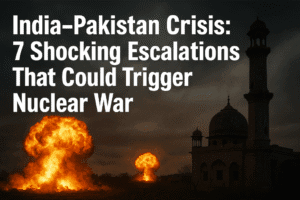India-Pakistan Crisis: 7 Shocking Escalations That Could Trigger Nuclear War
Tensions between nuclear-armed rivals India and Pakistan erupted into direct military confrontation this week after India launched airstrikes on Pakistani territory, marking the most severe escalation in over two decades. The strikes, dubbed “Operation Sindoor,” were retaliation for an April attack by Islamist militants that killed 26 Hindu tourists in Indian-administered Kashmir, which India blamed on Pakistan-based groups. Pakistan denied involvement, countered by downing multiple Indian jets and shelling border areas, killing at least 11 in Pakistan and three in India.
Both nations accused each other of targeting civilians, with Pakistan condemning strikes on mosques and homes, while India insisted it hit militant bases. Global powers, including the U.N. and U.S., urged restraint as cross-border shelling intensified and airlines suspended flights amid airspace closures. Analysts warn the crisis risks spiraling further, with Pakistan vowing a “proportional response” and historical grievances over Kashmir fueling distrust. The conflict underscores the perilous fragility of a region where past ceasefires have collapsed into war—and where millions now brace for the unthinkable.

India-Pakistan Crisis: 7 Shocking Escalations That Could Trigger Nuclear War
The fragile peace between India and Pakistan shattered this week as cross-border airstrikes, artillery exchanges, and claims of downed fighter jets marked the most severe military escalation between the nuclear-armed rivals in over two decades. The crisis, sparked by a deadly attack on Hindu tourists in Kashmir, has reignited fears of a wider conflict with global repercussions.
What Triggered the Strikes?
On April 15, 2024, an attack by Islamist militants in Indian-administered Kashmir killed 26 Hindu pilgrims, marking the deadliest assault on civilians in the region in years. India blamed Pakistan-based groups Jaish-e-Mohammed and Lashkar-e-Taiba, alleging Islamabad’s tacit support—a claim Pakistan denies. After weeks of diplomatic tension, India launched “Operation Sindoor” (named for the vermilion powder symbolizing Hindu matrimony), targeting what it called “terrorist infrastructure” in Pakistan and Pakistani-administered Kashmir.
The Escalation Unfolds
- India’s Offensive: Indian officials reported striking nine sites, including alleged militant headquarters. A defense source cited “restraint” in target selection, though Pakistan denied hitting militant camps, claiming civilian areas and mosques were struck.
- Pakistan’s Response: Islamabad claimed to shoot down five Indian jets, a figure unverified by India. However, local sources in Indian Kashmir confirmed three crashed aircraft, with pilots hospitalized. Cross-border shelling killed at least 11 in Pakistan and three in India, per officials.
- Human Toll: Images from Muzaffarabad, Pakistan’s Kashmir capital, showed a mosque’s collapsed minaret and residential damage. Survivors described nighttime explosions and fleeing families, while schools closed regionwide.
Historical Wounds Reopened
The strikes breach a 2003 ceasefire largely upheld since 2021, with India’s unprecedented targeting of mainland Pakistan (beyond Kashmir) signaling heightened aggression. Analysts note this response surpasses 2019’s Balakot airstrikes, which followed a Kashmir suicide bombing. “The scale here raises escalation risks,” said Michael Kugelman of the Wilson Center, highlighting Pakistan’s likely countermeasures.
Global Alarm and Economic Ripples
- Diplomatic Reactions: The U.S. and U.N. urged de-escalation, while India briefed allies like the U.S., UAE, and Saudi Arabia. Pakistan escalated matters by appealing to the U.N. Security Council, framing the strikes as “acts of war.”
- Local Impact: Airlines canceled flights amid airspace closures, and Indian stock futures dipped slightly. Pakistan’s Punjab province declared emergencies, with hospitals bracing for casualties.
Why This Crisis Feels Different
- Symbolism and Strategy: “Operation Sindoor” invokes cultural symbolism, reflecting India’s Hindu-nationalist rhetoric under Prime Minister Modi. Conversely, Pakistan’s emphasis on civilian casualties seeks international sympathy.
- Domestic Pressures: With India’s elections looming and Pakistan’s economic crisis, both governments face incentives to project strength.
- Mistrust and Miscalculation: Decades of Kashmir disputes, terror accusations, and three wars leave little diplomatic goodwill. A single misstep—like strikes near nuclear assets—could spiral.
What Comes Next?
Experts warn Pakistan’s response—whether cyberattacks, proxy militant strikes, or counter-raids—will dictate the crisis’ trajectory. Meanwhile, global powers face urgent pressure to mediate. As schools shutter and families flee border zones, the human cost mounts, underscoring the urgency of dialogue in a region where 1.5 billion lives hang in the balance.
While both nations have edged back from the brink before, the current combination of military assertiveness, political posturing, and historical grievances makes this flare-up uniquely perilous. The world watches nervously, aware that in South Asia, peace is often just a ceasefire away from collapse.
You must be logged in to post a comment.